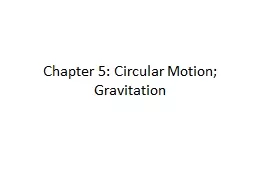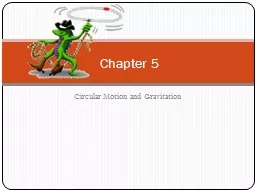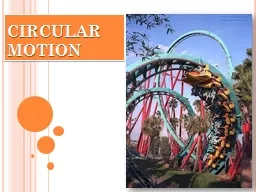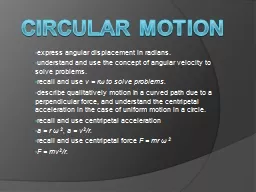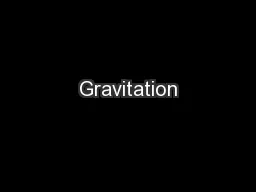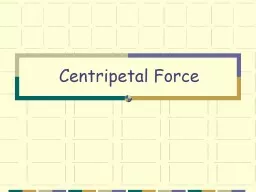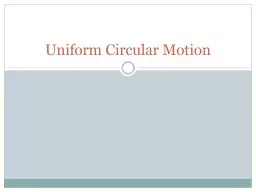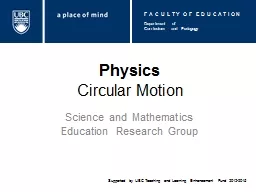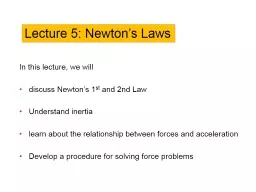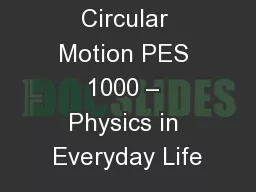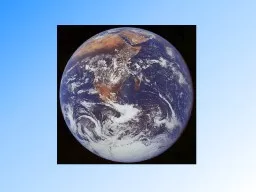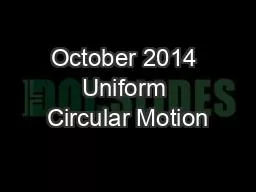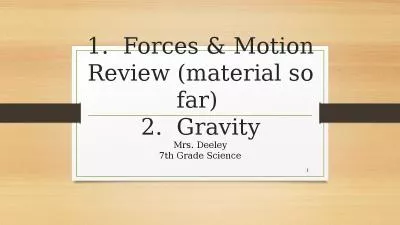PPT-Chapter 5: Circular Motion; Gravitation
Author : marina-yarberry | Published Date : 2017-04-19
Curves Forces act in straight lines An object will move in a straight line if there is NO force acting on it or if the net force acts in the direction of the motion
Presentation Embed Code
Download Presentation
Download Presentation The PPT/PDF document "Chapter 5: Circular Motion; Gravitation" is the property of its rightful owner. Permission is granted to download and print the materials on this website for personal, non-commercial use only, and to display it on your personal computer provided you do not modify the materials and that you retain all copyright notices contained in the materials. By downloading content from our website, you accept the terms of this agreement.
Chapter 5: Circular Motion; Gravitation: Transcript
Curves Forces act in straight lines An object will move in a straight line if there is NO force acting on it or if the net force acts in the direction of the motion BUT what if the net force acts at an angle to the motion. And 57375en 57375ere Were None meets the standard for Range of Reading and Level of Text Complexity for grade 8 Its structure pacing and universal appeal make it an appropriate reading choice for reluctant readers 57375e book also o57373ers students Chapter 5. Kinematics of Uniform Circular motion. An object that moves in a circle at constant speed, v, is said to be under uniform circular motion. . The magnitude of velocity remains constant.. The direction of velocity changes continuously.. Circular motion. We will be looking at a special case of kinematics and dynamics of objects in uniform circular motion (constant speed). Cars on a circular track (or on a curved road). Roller coasters in loop. express angular displacement in radians. . understand and use the concept of angular velocity to solve problems. . recall and use . v = r. ω. to solve problems. . describe qualitatively motion in a curved path due to a perpendicular force, and understand the centripetal acceleration in the case of uniform motion in a circle. . Physics 7C lecture 17. Tuesday December . 3. , 8:00 AM – 9:20 AM. Engineering Hall 1200. Introduction. What can we say about the motion of the particles that make up Saturn. ’. s rings?. Why doesn. Equations:. Academic Vocabulary:. Centripetal force. Centripetal acceleration. Circular motion. Tangential velocity. Inverse square law. Gravitational constant. Universal gravitational force. Weightlessness. Elizaveta. . Kudasova. 7 A. "Isaac Newton - . Исаак Ньютон" . Newton. , one of the greatest scientists of all times was born in 1642 in the little village in Lincolnshire, England. His father was a farmer and died before Newton was born. His mother was a clever woman whom he always . Circular Motion Lab Results. Part 1: Radius’ effect on velocity. Mass, centripetal force kept constant. Part 2: Mass’ effect on velocity. Radius, centripetal force kept constant. Part 3: Force’s effect on velocity. Supported by . UBC. Teaching and Learning Enhancement Fund . 2012-2015. Department of . Curriculum and Pedagogy. FACULTY OF EDUCATION. Question Title. Question Title. Circular Motion. http://. nwsphysics99.blogspot.ca. Centripetal acceleration. Problem solving with . Newton’s 2nd Law . for . circular motion. Lecture 8: Circular motion. Effect of force components . Components of force parallel and perpendicular to velocity have different effects.. Uniform Circular motion. For an object moving on a circle at constant speed. The . speed is constant. , but the . direction is not. Acceleration is a change in velocity, but speed is constant. The change in velocity is only in its direction. (missions Apollo) . TERRE - LUNE . (missions Apollo). MARS. JUPITER. SATURNE. Pluton. Charon. SOLEIL. Le premier calendrier lunaire . connu. : . un os sculpté du paléolithique. . . . . Uniform circular motion. What does the word “. uniform. ” mean here?. . constant radius. and . constant speed. . Velocity vector is tangent to the path at each instant, so direction of velocity vector changes all the time as the object moves in circle. . 2. Gravity. Mrs. Deeley. 7th Grade Science. 1. Review. Motion is a change in position over time. . Motion . is . described . in relation to a reference point. . Speed . is the rate of motion. . . Inertia .
Download Document
Here is the link to download the presentation.
"Chapter 5: Circular Motion; Gravitation"The content belongs to its owner. You may download and print it for personal use, without modification, and keep all copyright notices. By downloading, you agree to these terms.
Related Documents

